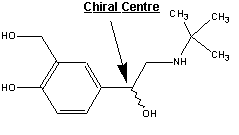

Tablets
Nebulizer Solution


Syrup
Inhaler Aerosol
Salbutamol may be ingested into the body in a number of ways as shown below
|
|
Tablets |
Nebulizer Solution |
|
|
Syrup |
Inhaler Aerosol |
Inhalation using a metered
dose inhaler
Inhalation with a nebulizer
A powder-filled capsule that is inhaled by using a device called
a dry powder inhaler
Swallowed as a liquid or tablet
Taken as shots.
Inhalation aerosols contain a microcrystalline suspension of salbutamol in CFC propellants with oleic acid. However, the other forms of ingesting Salbutamol make use of salbutamol sulphate instead, either as a powder or in liquid solution.
The chiral centre present in both forms of salbutamol results in the compounds demonstrating optical isomerism. Furthermore, only one of these isomers, (R)-salbutamol causes bronchodilation to occur. Recently this isomer, known as levalbuterol, has been approved by the FDA for use with nebulizers. Levalbuterol has been found to be considerably more effective than the racemic mixtures of the drug used previously.

There has been much speculation about the possible adverse effect of the S-isomer on inducing airway hyper-responsiveness, with many proposing that the S-isomer is associated with the increased morbidity and mortality with regular b2-agonist use. However, current evidence is thin and far from conclusive. All that can be said is that the S-isomer has no beneficial contribution to the process of bronchodilation.